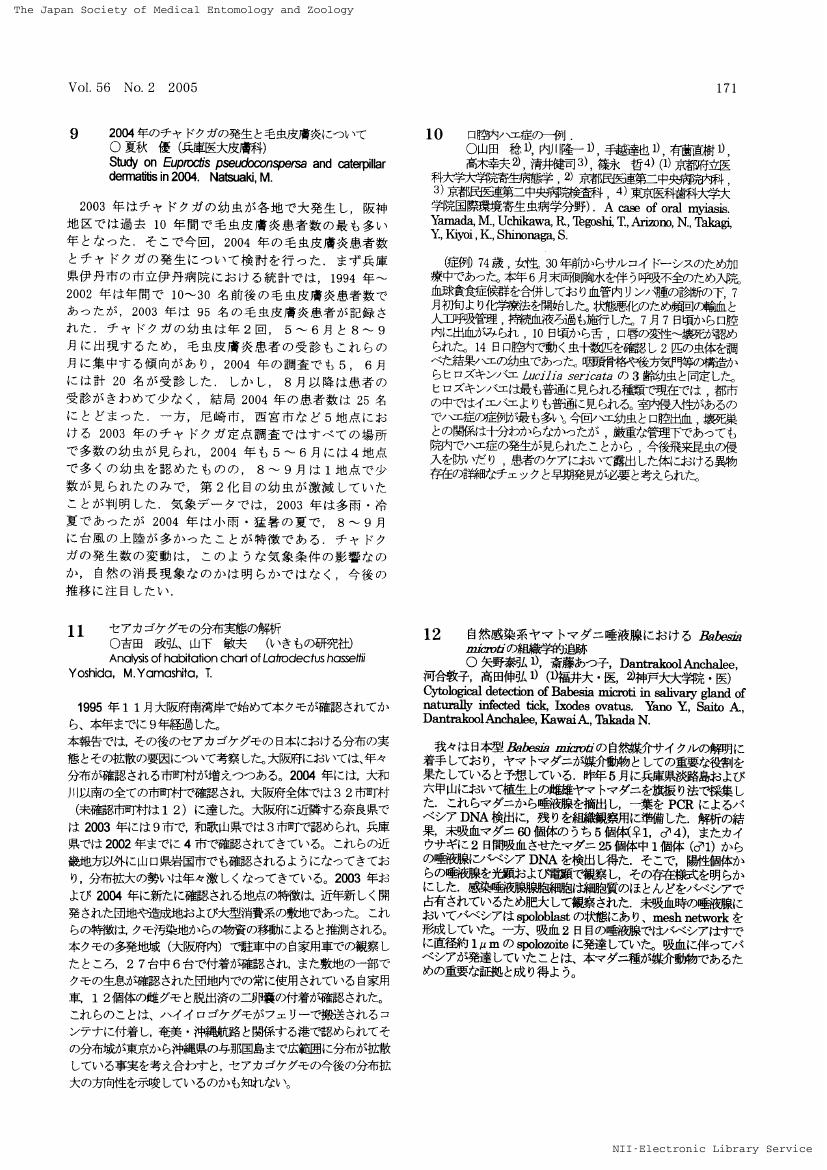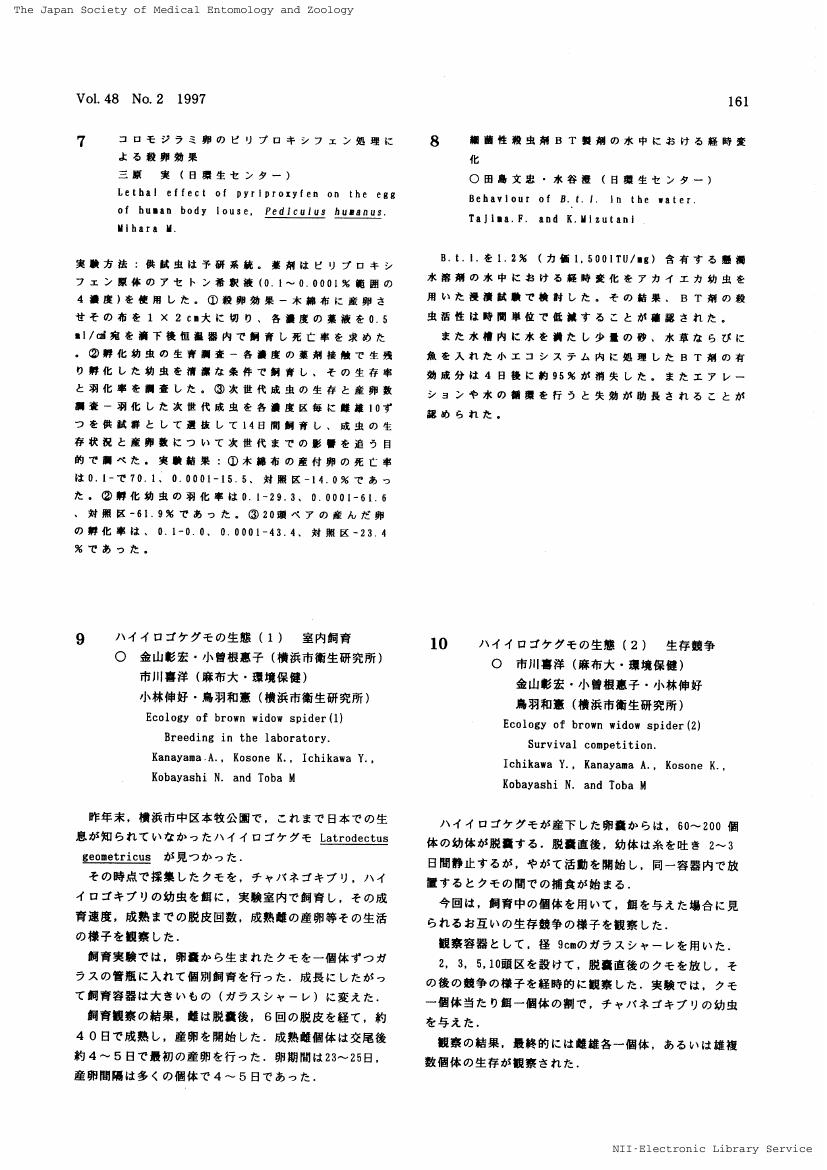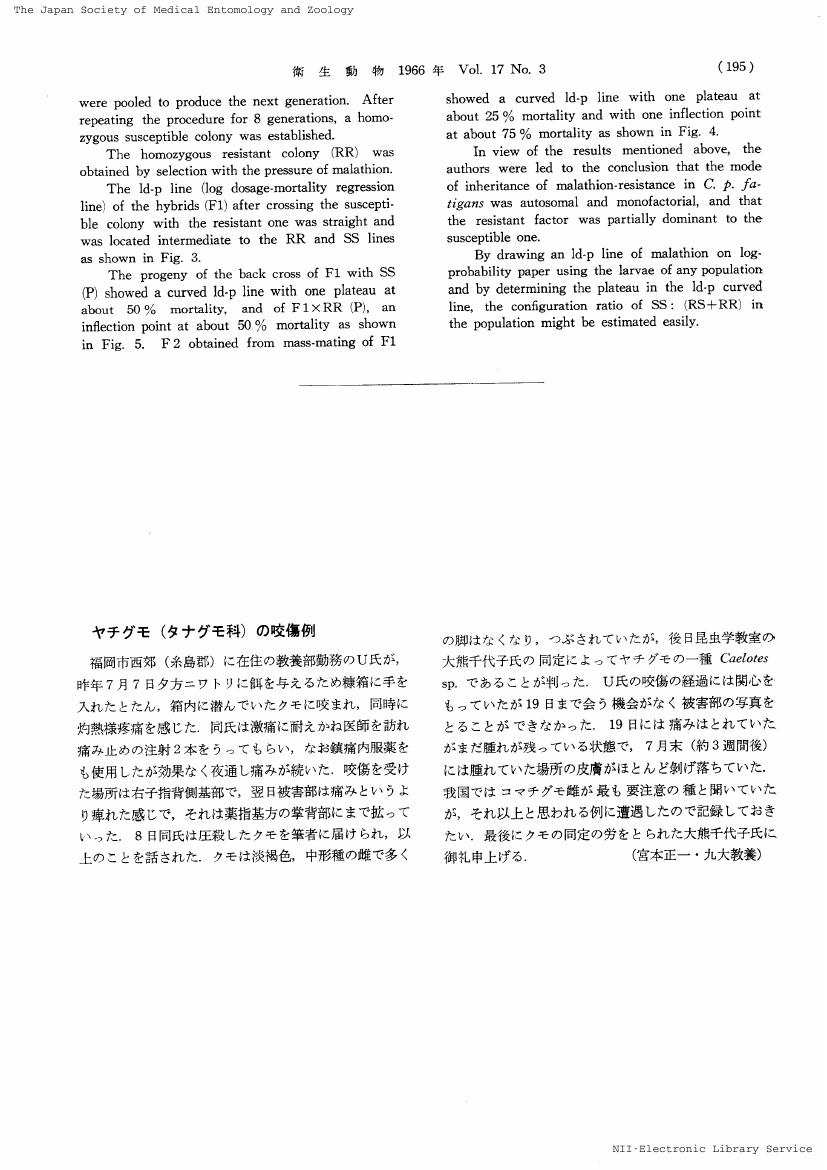1 0 0 0 OA 11 セアカゴケグモの分布実態の解析(第59回日本衛生動物学会西日本支部大会講演要旨)
- 著者
- 吉田 政弘 山下 敏夫
- 出版者
- 日本衛生動物学会
- 雑誌
- 衛生動物 (ISSN:04247086)
- 巻号頁・発行日
- vol.56, no.2, pp.171, 2005-06-15 (Released:2016-08-07)
1 0 0 0 OA 2 日本における毒グモの分布と今後の動向(第2回日本衛生動物学会西日本支部例会講演要旨)
- 著者
- 吉田 政弘
- 出版者
- 日本衛生動物学会
- 雑誌
- 衛生動物 (ISSN:04247086)
- 巻号頁・発行日
- vol.59, no.2, pp.129-130, 2008-06-15 (Released:2016-08-06)
- 著者
- 大利 昌久
- 出版者
- 日本衛生動物学会
- 雑誌
- 衛生動物 (ISSN:04247086)
- 巻号頁・発行日
- vol.29, no.4, pp.361-364, 1978-12-15 (Released:2016-09-05)
- 被引用文献数
- 1 1
An epidemiological survey by questionnaire was made on arachnidism caused by the spider, Chiracanthium japonicum, in Japan. Among 42 arachnologists and 79 medical doctors, who are interested in arachnidism, 90 researchers submitted clinical records of bite cases in response to the questionnaire. A total of 28 patients of arachnidism was reported from different prefectures including Hokkaido, Aomori, Fukushima, Iwate, Miyagi, Gumma, Kanagawa, Yamanashi, Aichi, Wakayama, Mie, Nagasaki and Saga. Analysis of these 28 cases was made in which the sex of causative spiders, seasonal frequency, age and sex distribution of patients, location bitten, site of bites, severity and duration of time suffered were examined. From this epidemiological analysis, arachnidism caused by Chiracanthium japonicum was summarized as follows : A) The arachnidism occurred very commonly in Japan during a period of four months from May to August, with a peak in June. B) During the mating season the male spiders searching for mates accidentally infest human hibitats and inflict their bites most commonly during the midnight hour while the humans are sleeping. C) The site of bites was most frequently observed in the upper extremities. D) A drastic difference is observed in arachnidism caused by male versus female spiders. Male spiders produce sharp pain at the bite while the female causes intensive itching. However, both sexes produce redness over the skin lesion.
- 著者
- 大利 昌久
- 出版者
- 日本衛生動物学会
- 雑誌
- 衛生動物 (ISSN:04247086)
- 巻号頁・発行日
- vol.29, no.2, pp.139-145, 1978-06-15 (Released:2016-09-05)
Arachnidism caused by the genus Chiracanthium has been reported from subtropical or warm temperate zones in all over the world. So far in Japan, total 50 cases of arachnidism caused by C. japonicum, which is recognized to be most dangerous, were recorded and analized epidemiologically from the medical points of view up to 1976. The investigation was made on the function and the histology of the venom apparatus for the purpose of analysing the cause of arachnidism. The venom apparatus is associated with the chelicerae or first pair of appendages of the cephalothorax. Each consists of a large basal segment and a terminal claw-like fang piecerced by the duct from the venom gland. The fang of male is about two times longer than that of female, therefore, the fangs of male was found to be able to penetrate the palmar skin of volunteer more deeper than that of female. The muscularis was found to cover the whole gland beginning from the neck of the gland. This is the bundle of fibers of striated-muscle. The basement membrane from a continuous layer under the muscularis. The two kinds of epithelial cells were observed lining the basement membrane. The first layer is formed by small and low cells with an ovarial nucleus. The second layer is formed by high columnar cells attaching on the basement membrane. Both the nuclei of the first and the second cells show the same morphological structure by the optical microscopy.
1 0 0 0 OA 1 群馬県内で発生したカバキコマチグモ咬傷について
1 0 0 0 OA 1 千葉県におけるクモの同定依頼
- 著者
- 角田 隆 藤曲 正登
- 出版者
- 日本衛生動物学会
- 雑誌
- 衛生動物 (ISSN:04247086)
- 巻号頁・発行日
- vol.51, no.2, pp.119, 2000-06-15 (Released:2016-08-09)
1 0 0 0 OA B39 セアカゴケグモの防除について
1 0 0 0 OA 133 日本に上陸したセアカゴケグモについて : (2) 低温下における飼育成績
1 0 0 0 OA B09 日本におけるハイイロゴケグモの分布 (2002)
- 著者
- 吉田 政弘
- 出版者
- 日本衛生動物学会
- 雑誌
- 衛生動物 (ISSN:04247086)
- 巻号頁・発行日
- vol.54, no.supplement, pp.37, 2003-04-01 (Released:2016-08-07)
1 0 0 0 OA B10 セアカゴケグモの分布拡大と拡散
- 著者
- 吉田 政弘
- 出版者
- 日本衛生動物学会
- 雑誌
- 衛生動物 (ISSN:04247086)
- 巻号頁・発行日
- vol.54, no.supplement, pp.37, 2003-04-01 (Released:2016-08-07)
1 0 0 0 OA 9 ハイイロゴケグモの生態 : (1) 室内飼育
1 0 0 0 OA 10 ハイイロゴケグモの生態 : (2) 生存競争
1 0 0 0 OA ヤチグモ (タナグモ科) の咬傷例
- 著者
- 宮本 正一
- 出版者
- 日本衛生動物学会
- 雑誌
- 衛生動物 (ISSN:04247086)
- 巻号頁・発行日
- vol.17, no.3, pp.195, 1966-10-31 (Released:2016-09-05)
1 0 0 0 OA B35 日本に上陸したセアカゴケグモについて (6) : 毒腺抽出物の発痛作用
1 0 0 0 OA カバキコマチグモ毒の物理・化学・生物学的性状
- 著者
- 大利 昌久
- 出版者
- 日本衛生動物学会
- 雑誌
- 衛生動物 (ISSN:04247086)
- 巻号頁・発行日
- vol.47, no.3, pp.231-237, 1996-09-15 (Released:2016-08-23)
- 参考文献数
- 32
Determination of the chemical properties of the venom of Chiracanthium japonicum, which is well known as the most medically important spider in Japan, was studied. The venom was prepared by dissecting out the venom glands from mature female spiders. Then the glands were homogenized in phosphate buffer solution (PBS) with a glass homogenizer. The clear, viscous surpernatant obtained by centrifugation was stored in a small vial and regarded as the crude venom. This venom was fractionated on a Sephadex G-200 column. The white mice (JCL) were injected intraperitoneally with 0.2ml of different concentrations of the fractionated venom. The lethal activity was noted. Lethal activity was fractionated on a CM Sephadex C-50 column. The fractions were regarded as the purified venom. The toxic responses to mice were dyspnea, prostration, flaccid paralysis and death. The lethal activity was determined to be neurotoxic in action. The minimal lethal dose (MLD) of the purified venom for mice was 10μg. The house-fly was used for the toxicity test. The LD_<50> was 0.069μg/honsefly. The erythematic activity on rabbit hide was examined by injecting the venom intradermally. The minimal redness dose (MRD) to evoke 10×10mm size of redness in the rabbit was 0.7μg. The molecular weight of purified protein was 63,000±2,000. The toxicity to mice was completely destroyed by heating at 60℃ in 10 minutes and lost at 0℃ in five to seven days.
1 0 0 0 OA 1 日本に上陸したセアカゴケグモについて : (3) 飼育成績
1 0 0 0 OA 2 Latrodectus hasseltii の産卵状態について
1 0 0 0 OA クモ刺咬症の 10 例について
- 著者
- 大利 昌久
- 出版者
- 日本衛生動物学会
- 雑誌
- 衛生動物 (ISSN:04247086)
- 巻号頁・発行日
- vol.26, no.2-3, pp.83-87, 1975-08-15 (Released:2016-09-05)
1954年から1974年の過去20年間に著者が経験した5種のクモによる10症例の刺咬症を報告した。その他既報例を合わせ9種のクモによる16症例について, クモ刺咬症の発症時期, 発症原因, 被害患者の性, 年代, 病害の程度, 治療の問題点を明らかにした。5月から8月の暖かい季節に発症し, クモを直接手で捕えようとする瞬間に受傷するのが多く, 刺咬部は四肢, とくに上肢に多い。受傷患者は10代に多く, ほとんど男性であった。全症例を病害の程度に従って無症状, 軽症, 中等症, 重症の4つに分類したが, 重症例はセアカゴケグモとカバキコマチグモの2種であった。クモ刺咬部の治療上とくに問題になったのは, 受傷後も持続する耐えがたい痛みに対する治療法で, 一般の視床, 脊髄性鎮痛剤では著効をえられなかったことである。本邦において今迄に報告されたクモ刺咬症についても考察を行った。















